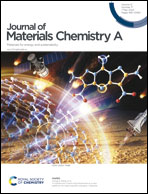Facilitated explosion of nitro compounds confined in metal–organic frameworks†
Abstract
The unique properties of metal–organic frameworks (MOFs), such as a high surface area, micro- and meso-porosity, and evenly distributed metal sites, make them potent catalysts for various chemical reactions. These reactions are facilitated by acidic open sites or defect sites on the MOF nodes. This study demonstrates the facilitated explosion of 2,4,6-trinitrotoluene (TNT) confined in MOFs via a simple thermal treatment. Through gas adsorption measurements and electron microscopy, we showed that TNT confinement in the pores of MOFs alters their characteristics to non-porous, while maintaining their overall shape. We also explored the electron transfer interaction between MOFs and TNT using infrared spectroscopy, X-ray photoelectron spectroscopy, and density functional theory calculations, which revealed the altered chemical structure of TNT. The thermal decomposition temperature and thermal activation energy of TNT decreased significantly upon confinement in MOFs, as evidenced by a decrease in activation energy from 76 to 7 J required for the initiation of an explosion compared to that of neat TNT, and the mechanical sensitivity markedly increased. This highlights the substantial impact of MOFs, particularly their capacity to amplify the reactivity of confined substances.



 Please wait while we load your content...
Please wait while we load your content...